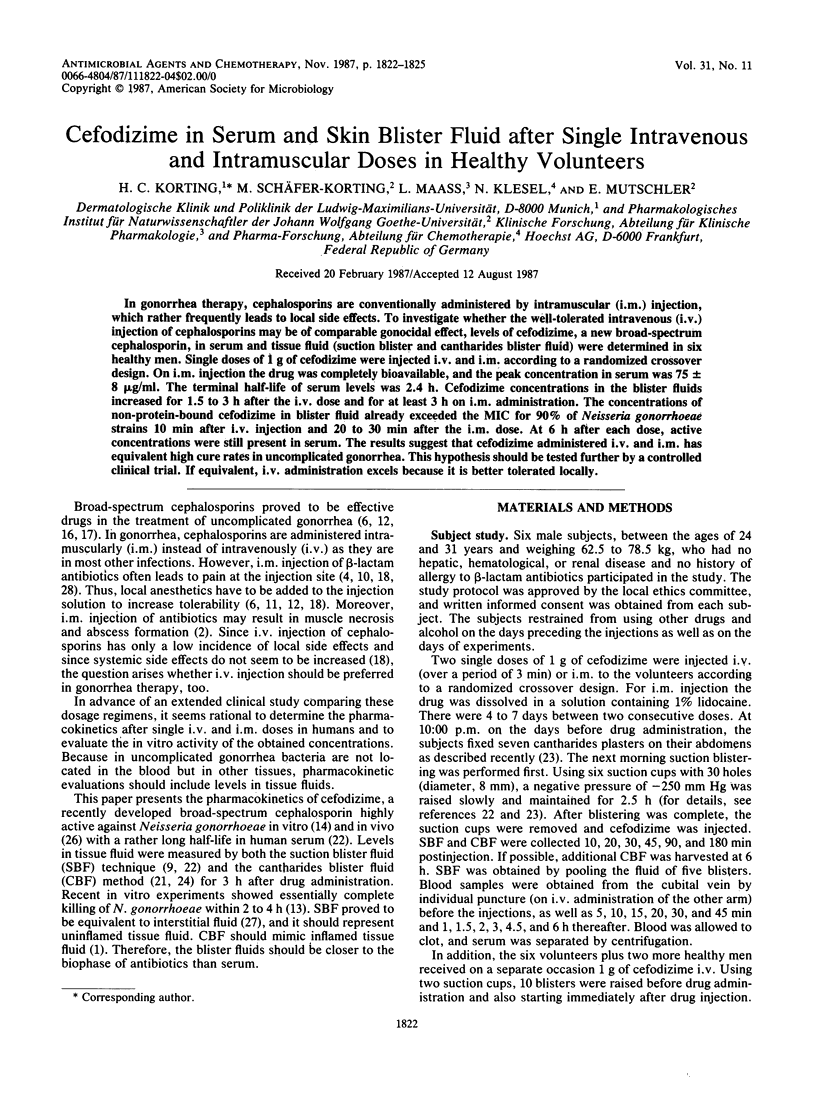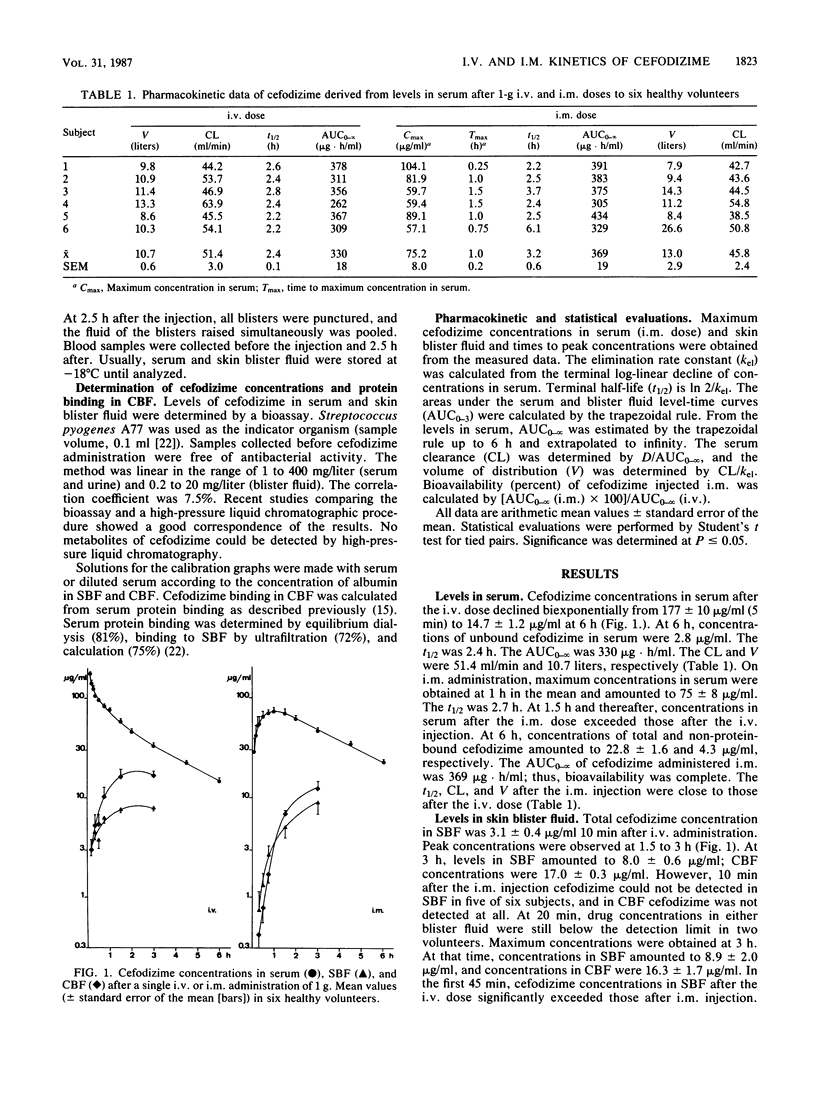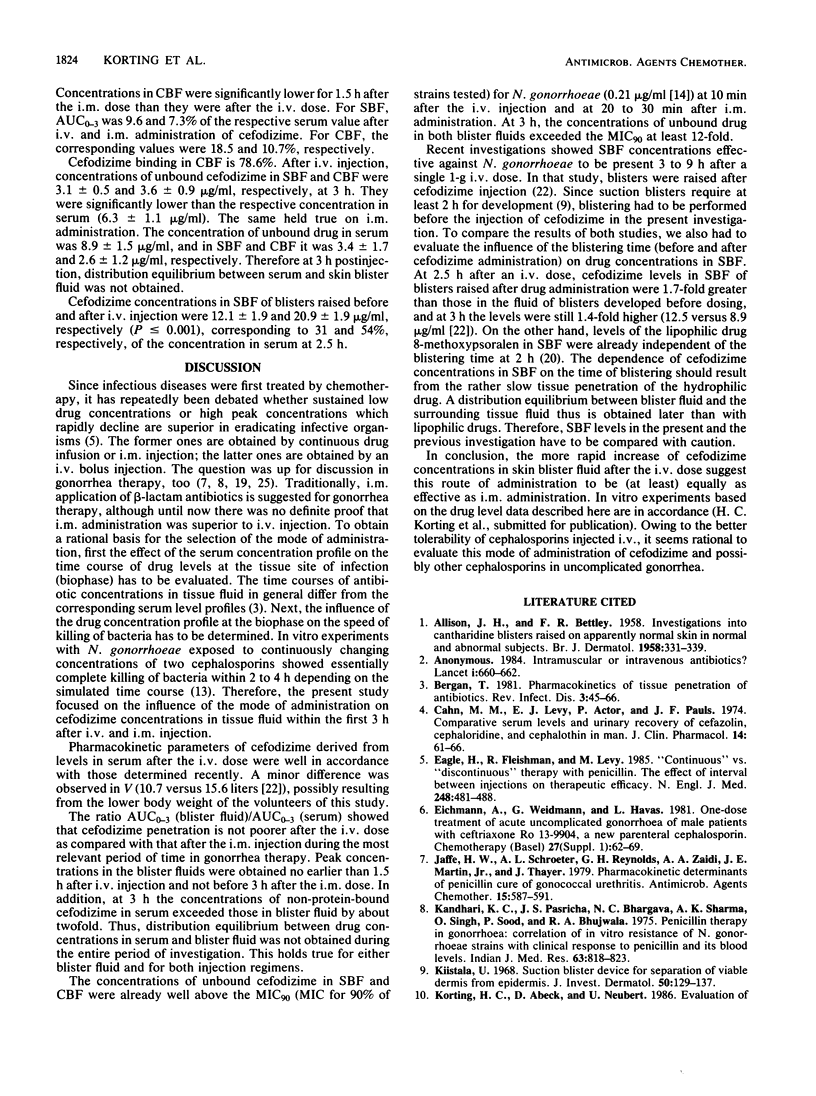Abstract
In gonorrhea therapy, cephalosporins are conventionally administered by intramuscular (i.m.) injection, which rather frequently leads to local side effects. To investigate whether the well-tolerated intravenous (i.v.) injection of cephalosporins may be of comparable gonocidal effect, levels of cefodizime, a new broad-spectrum cephalosporin, in serum and tissue fluid (suction blister and cantharides blister fluid) were determined in six healthy men. Single doses of 1 g of cefodizime were injected i.v. and i.m. according to a randomized crossover design. On i.m. injection the drug was completely bioavailable, and the peak concentration in serum was 75 +/- 8 micrograms/ml. The terminal half-life of serum levels was 2.4 h. Cefodizime concentrations in the blister fluids increased for 1.5 to 3 h after the i.v. dose and for at least 3 h on i.m. administration. The concentrations of non-protein-bound cefodizime in blister fluid already exceeded the MIC for 90% of Neisseria gonorrhoeae strains 10 min after i.v. injection and 20 to 30 min after the i.m. dose. At 6 h after each dose, active concentrations were still present in serum. The results suggest that cefodizime administered i.v. and i.m. has equivalent high cure rates in uncomplicated gonorrhea. This hypothesis should be tested further by a controlled clinical trial. If equivalent, i.v. administration excels because it is better tolerated locally.
Full text
PDF



Selected References
These references are in PubMed. This may not be the complete list of references from this article.
- ALLISON J. H., BETTLEY F. R. Investigations into cantharidin blisters raised on apparently normal skin in normal and abnormal subjects. Br J Dermatol. 1958 Oct;70(10):331–339. doi: 10.1111/j.1365-2133.1958.tb13792.x. [DOI] [PubMed] [Google Scholar]
- Bergan T. Pharmacokinetics of tissue penetration of antibiotics. Rev Infect Dis. 1981 Jan-Feb;3(1):45–66. doi: 10.1093/clinids/3.1.45. [DOI] [PubMed] [Google Scholar]
- Cahn M. M., Levy E. J., Actor P., Pauls J. F. Comparative serum levels and urinary recovery of cefazolin, cephaloridine, and cephalothin in man. J Clin Pharmacol. 1974 Jan;14(1):61–66. doi: 10.1002/j.1552-4604.1974.tb02289.x. [DOI] [PubMed] [Google Scholar]
- EAGLE H., FLEISCHMAN R., LEVY M. "Continuous" vs. "discontinuous" therapy with penicillin; the effect of the interval between injections on therapeutic efficacy. N Engl J Med. 1953 Mar 19;248(12):481–488. doi: 10.1056/NEJM195303192481201. [DOI] [PubMed] [Google Scholar]
- Eichmann A., Weidmann G., Havas L. One-dose treatment of acute uncomplicated gonorrhoea of male patients with ceftriaxone Ro 13-9904, a new parenteral cephalosporin. A dose-range finding pilot study using doses of 500, 250, 125 and 50 mg respectively, in descending order. Chemotherapy. 1981;27 (Suppl 1):62–69. doi: 10.1159/000238031. [DOI] [PubMed] [Google Scholar]
- Jaffe H. W., Schroeter A. L., Reynolds G. H., Zaidi A. A., Martin J. E., Jr, Thayer J. D. Pharmacokinetic determinants of penicillin cure of gonococcal urethritis. Antimicrob Agents Chemother. 1979 Apr;15(4):587–591. doi: 10.1128/aac.15.4.587. [DOI] [PMC free article] [PubMed] [Google Scholar]
- Kandhari K. C., Pasricha J. S., Bhargava N. C., Sharma A. K., Singh O. P., Sood P., Bhujwala R. A. Pencillin therapy in gonorrhoea: correlation of in vitro resistance of N. gonorrhoeae strains with clinical response to penicillin and its blood levels. Indian J Med Res. 1975 Jun;63(6):818–823. [PubMed] [Google Scholar]
- Kiistala U. Suction blister device for separation of viable epidermis from dermis. J Invest Dermatol. 1968 Feb;50(2):129–137. doi: 10.1038/jid.1968.15. [DOI] [PubMed] [Google Scholar]
- Korting H. C., Neubert U. Susceptibility of Neisseria gonorrhoeae to ceftizoxime in vitro and in vivo. Chemotherapy. 1984;30(5):322–327. doi: 10.1159/000238287. [DOI] [PubMed] [Google Scholar]
- Korting H. C., Neubert U. Treatment of gonorrhoea with cefotiam: activity in vitro and clinical results of a 1-gram single-dose regimen. Dermatologica. 1985;171(4):264–268. doi: 10.1159/000249435. [DOI] [PubMed] [Google Scholar]
- Korting H. C., Niederauer H., Ollert M. Bactericidal activity of cefotiam and ceftizoxime against Neisseria gonorrhoeae in an in vitro model simulating plasma and cantharidal blister fluid levels after the single intramuscular application of one gram. Chemotherapy. 1986;32(3):260–269. doi: 10.1159/000238423. [DOI] [PubMed] [Google Scholar]
- Limbert M., Klesel N., Seeger K., Seibert G., Winkler I., Schrinner E. Cefodizime, an aminothiazolylcephalosporin. I. In vitro activity. J Antibiot (Tokyo) 1984 Aug;37(8):892–900. doi: 10.7164/antibiotics.37.892. [DOI] [PubMed] [Google Scholar]
- McNamara P. J., Gibaldi M., Stoeckel K. Fraction unbound in interstitial fluid. J Pharm Sci. 1983 Jul;72(7):834–836. doi: 10.1002/jps.2600720735. [DOI] [PubMed] [Google Scholar]
- Neubert U., Korting H. C., Ruckdeschel G. Susceptibility of Neisseria gonorrhoeae to cefotaxime: in vitro studies and treatment results. Arch Dermatol Res. 1982;274(3-4):321–326. doi: 10.1007/BF00403736. [DOI] [PubMed] [Google Scholar]
- Rajan V. S., Sng E. H., Thirumoorthy T., Goh C. L. Ceftriaxone in the treatment of ordinary and penicillinase-producing strains of Neisseria gonorrhoeae. Br J Vener Dis. 1982 Oct;58(5):314–316. doi: 10.1136/sti.58.5.314. [DOI] [PMC free article] [PubMed] [Google Scholar]
- Richards D. M., Heel R. C., Brogden R. N., Speight T. M., Avery G. S. Ceftriaxone. A review of its antibacterial activity, pharmacological properties and therapeutic use. Drugs. 1984 Jun;27(6):469–527. doi: 10.2165/00003495-198427060-00001. [DOI] [PubMed] [Google Scholar]
- SABATH L. D., KIVLAHAN J. J. Dosage of penicillin for acute gonorrhea of males. Am J Med Sci. 1961 Dec;242:663–672. doi: 10.1097/00000441-196112000-00001. [DOI] [PubMed] [Google Scholar]
- Schäfer-Korting M., Grimm H. W., Mutschler E. Morphologische, Biochemische und Pharmakokinetische Untersuchungen an Saugblasen in Abhängigkeit von der Art und dem Zeitpunkt ihrer Entstehung. Arch Pharm (Weinheim) 1985 Aug;318(8):711–720. doi: 10.1002/ardp.19853180809. [DOI] [PubMed] [Google Scholar]
- Schäfer-Korting M., Korting H. C., Hiemstra S., Mutschler E. Does cantharides blister fluid provide access to the peripheral compartment? Eur J Clin Pharmacol. 1982 Oct;23(4):327–330. doi: 10.1007/BF00613614. [DOI] [PubMed] [Google Scholar]
- Schäfer-Korting M., Korting H. C., Maass L., Klesel N., Grigoleit H. G., Mutschler E. Cefodizime penetration into skin suction blister fluid following a single intravenous dose. Eur J Clin Pharmacol. 1986;30(3):295–298. doi: 10.1007/BF00541531. [DOI] [PubMed] [Google Scholar]
- Schäfer-Korting M., Korting H. C., Mutschler E. Human plasma and skin blister fluid levels of griseofulvin following a single oral dose. Eur J Clin Pharmacol. 1985;29(1):109–113. doi: 10.1007/BF00547378. [DOI] [PubMed] [Google Scholar]
- Simon C., Malerczyk V., Brahmstaedt E., Toeller W. Cefazolin, ein neues Breitspektrum-Antibiotikum. Dtsch Med Wochenschr. 1973 Dec 21;98(51):2448–2450. doi: 10.1055/s-0028-1107275. [DOI] [PubMed] [Google Scholar]
- Vermeer B. J., Reman F. C., van Gent C. M. The determination of lipids and proteins in suction blister fluid. J Invest Dermatol. 1979 Oct;73(4):303–305. doi: 10.1111/1523-1747.ep12531833. [DOI] [PubMed] [Google Scholar]
- Yates R. A., Cockshott I. D., Houghton H. L., Wardleworth A., Adam H., Donnelly R. J. Pharmacokinetics and tolerance of single intramuscular doses of cefotetan in normal Caucasian volunteers. J Antimicrob Chemother. 1983 Jan;11 (Suppl):207–212. doi: 10.1093/jac/11.suppl_a.207. [DOI] [PubMed] [Google Scholar]


